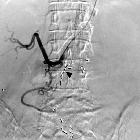carman meniscus sign
The Carman meniscus sign describes the lenticular shape of barium in cases of large and flat gastric ulcers, in which the inner margin is convex toward the lumen. It usually indicates a malignant ulcerated neoplasm; in cases of benign gastric ulcers, the inner margin is usually concave toward the lumen .
Carman meniscus sign is seen after compression of a gastric tumor that surrounds the lesser curvature thus apposing both surfaces of the surrounding tumor and entrapping contrast between these margins causing a semilunar configuration.
The following must be present in order to visualize the sign :
- flat infiltrating ulcerative lesion with heaped-up margins.
- saddle region of the stomach i.e. lesser curvature of body or antrum
- examination should be single-contrast or biphasic study (sign may be visible in double contrast study but may be not recognized).
- compression must be applied to the stomach.
History and etymology
It is named after Russell Daniel Carman (1875-1926), a Canadian by birth, and a professor of roentgenology at the Mayo Clinic from 1913-1926 . He was one of the pioneers of gastrointestinal radiology. The sign was described in the 1920s prior to double-contrast studies .
He was past-President of both the American College of Radiology and Radiological Society of North America . He was also President-elect of the American Roentgen Ray Society at the time of his death. Ironically he was diagnosed with inoperable gastric carcinoma in 1925, leading to his premature death .
See also
Siehe auch:

 Assoziationen und Differentialdiagnosen zu carman meniscus sign:
Assoziationen und Differentialdiagnosen zu carman meniscus sign:
